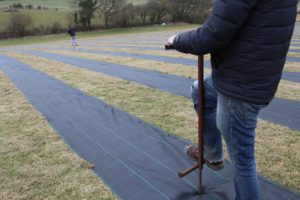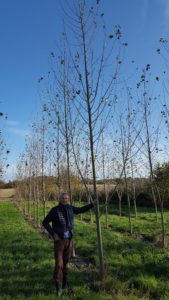Woodfuel self supply – advice for smallholders
I am losing count of the number of queries we get from small holders all of whom have a small patch of land and want to grow their own firewood. I seem to be writing the same email again and again and have decided it’s time to commit this information to a blog.
Let’s consider a smallholder with say one acre (0.4 hectares) of land who lives in a country dwelling. Let’s assume that the occupant has an oil boiler but because of the draughty nature of the house, the expense of oil and the carbon footprint associated with fossil fuels prefers to rely on space heating in a main reception room from a wood stove.
Let’s also assume they have a 5 kW log stove, that is used for 10 hours a day. As long as it is topped up fairly regularly with logs the average heat output is going to be around 2.5 kW and assuming an efficiency of around 70% then they would need 36 kW of input fuel per day. If they use their stove for 150 days per year then their requirement is ~5,350 kilowatt hours (kWh) of input fuel per year. Seasoned dry logs are 4,000 kWh per tonne so they would need 1.34 tonnes of air dry logs per year.
Yields are tricky to predict. However, if the land is prepared properly, weed competition is kept to a minimum and rabbits and deer are kept at bay (particularly in the early stages of establishment) it should be reasonable to achieve 8 oven dry tonnes (or 10 tonnes at 20% moisture content) per hectare per year with the biomass planting material we sell.
This would entail a total requirement of 0.134 hectares (or a third of an acre). I would increase this by 35% to allow for some failures within the plantation and losses during harvest so around 0.18 hectares in total. I would suggest that it be planted in three blocks of equal size.
Even at this micro scale I would avoid planting it all in one go. You could make some mistakes, have some bad luck with the weather and end up spending a lot of money on a doomed project. Planning is everything so don’t rush and plant up 33% of the available area in the first spring and learn whilst you go. After that first year you may want to refine your species choice, your planting spacing etc.
I usually suggest to customers that if it was me I would plant some willow, poplar and eucalypts. There are really good willows and poplars that lend themselves to firewood production such as Endurance and Resolution and A4A and Griminge. Eucalypts produce denser wood over a longer period. There are lots of Eucalyptus species and the choice is highly site specific. We have provided details on our price list page but it’s good idea to ask our advice before making an order.
The rotations and spacings would be as follows:
- Willow – 4 years , 10,000 plants per hectare (e.g. 1 m x 1 m). Please note this is a wider spacing and longer rotation than commercial SRC to allow thicker stem diameters to be produced. If you planted 33% of your 0.06 ha plot in year 1 with willows you would need 198 setts. I always aim to plant in mid-March if the soil allows.
- Poplar – 5-6 years, 6,250 plants per hectare (1 m x 1.6 m). If you planted 33% of your 0.06 ha plot in year 1 with poplars you would need 124 setts. I also aim to plant in mid-March if the soil allows.
- Eucalyptus 8 years (although it is possible to thin after year 4-5), 1,666 plants per hectare (3 m x 2 m) – If you planted 33% of your 0.06 ha plot in year 1 with Eucalyptus you would need 33 plug plants. Eucs are planted from early May onwards and the planting window is fairly short.

Planting through membrane is an option but you need to peg it down well and use a dibber to make 20-30cm holes.
This is one example. You may wish to plant a greater % of Eucs in order to increase the better quality logs in the future or omit them completely if you think they don’t fit in to your landscape or don’t like the fact that they have poor biodiversity value. However, this gives you something to go on.
So if we consider that 0.18 hectares will be established then it could be managed as follows:
- Year 1 – plant 0.06 hectares
- Year 2 – plant 0.06 hectares and gap up any misses in year 1 plot
- Year 3 – Plant 0.06 hectares and gap up any misses in year 2 plot
- Year 4 – Gap up any misses in year 3 plot
- Year 5 – Harvest willows from year 1 planting
- Year 6 – Harvest willows from year 2 planting, Harvest some poplars from year 1 planting, thin year 1 Eucalyptus
- Year 7 – Harvest willows from year 3 planting, remaining poplar from year 1 planting and some from year 2 planting, thin year 2 Eucalyptus
- Year 8 – Harvest some willows from year 1 planting, remaining poplars from year 2 planting, some poplars from year 3 planting, thin year 3 Eucalyptus
- Etc
After a short while you’ll get a feeling for what you need and what’s ready to harvest.
The other thing to consider is how are you preparing the land. On such a small scale is it really a good idea to plough? You may end up bringing lots of redundant seeds to the surface so perhaps a no till option is better.
Planting through membrane is one way of keeping the weeds at bay but isn’t to everyone’s taste. Alternatively, you could spray the strips of land that you want to plant and mulch thereafter. Personally, I have sometimes sprayed, laid membrane and mulched – I think that’s belt, braces and a bit of extra rope thrown in!
If you are planting through membrane or into sprayed off grass then you will need longer setts – 40 cm as a minimum. 20cm cuttings only really work in impeccably prepared soils.
If money is no object and you want the best log quality wood from growing willow and poplar you may consider planting long setts. Poplar and willow can grow perfectly well as single stemmed trees in this way (as long as you rub out the side shoots). 2m long setts are perfect for this – you will get a good sized tree quickly but it is more expensive. Also, you will need to fashion a metal dibber so they can be pushed into the soil a good distance. A two metre rod needs to be pushed in at least 30 cm. This can be tough work but needs to be done well. If they are not fully pushed in you will be wasting your money.
So, there’s a good introduction to planting at a small scale. There are lots of possible permutations but this blog serves as a good starting point to base your cropping plan on.
Please contact me for further information and to make your order!
If you want to read about the woodfuel characteristics of willow, poplar and Eucalyptus read this other blog.
Want to know how to use your wood burning stove correctly? We recommend the following book: The Log Book: Getting The Best From Your Woodburning Stove by Will Rolls. Buy it here.
